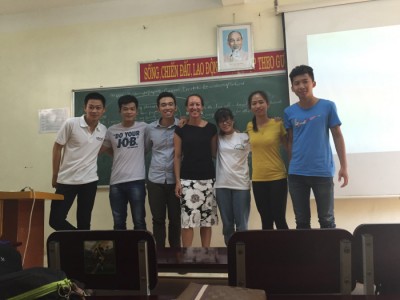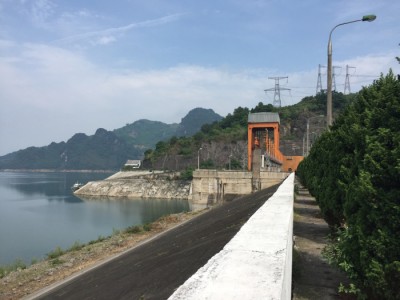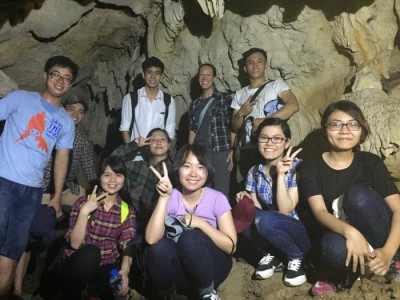This summer CSU faculty member Kristie Yelinek is teaching a composition class at the Forestry University of Vietnam in the city of Xuan Mai. She has been recording her experiences teaching and traveling around Vietnam in a blog, “Teaching and Other Adventures: Vietnam.” The following is an excerpt from her blog that explains some of the adventures she has been having with her students.

On Thursday (May 19th) my students took me on another adventure to visit some sights close to Xuan Mai. We started bright and early, 7 am, so that we could try to miss the heat of the day when driving on motor bikes. There were 16 of us, two to a motor bike, and along the way, the student I was riding with asked if I wanted to drive the bike for a little bit. The road was fairly empty, so I gave it a shot. It was pretty fun, although I was happy to turn the driving over to him when we got close to a busy and confusing street market.
Our first stop was the Hoa Binh (pronounced “Hwah Bing”) hydroelectric dam, about an hour’s drive away. The dam is the largest hydroelectric dam in Vietnam, as well as South East Asia and my students said this is where our power in Xuan Mai comes from. We seemed to be the only ones there, although my students said that typically the dam has a lot of tourists visiting it and for it to be so empty was rare.

From the dam, we headed up a small hill to visit a statue of Ho Chi Minh. On the way there, the student who I was riding with was pulled over by the police (we passed through a tunnel and his headlight wasn’t working). When we stopped, we both got off the bike and the officers started to talk to the student. One of them glanced in my direction, looked surprised and said, “Oh! Hello!” And again, this was the end of our shared language. He gestured to me to move to the side, so I did, but he kept waving his hand at me to go further until I was in a teeny, tiny piece of shade. He pointed at the sun, pointed at me in the shade, and smiled. Communication accomplished! Whether it was the fact that I was with him or his own sweet-talking, the student got off without a ticket and we continued on to the statue.
The statue of Ho Chi Minh was constructed at about the same time as the dam and is rather impressive at about 60 feet tall. You can see it as you approach the dam. Once at the statue, you have a good view of the city of Hoa Binh and the river flowing from the dam. At the statue, you can buy flowers and incense to leave to pay your respects to Ho Chi Minh, or “Uncle Ho,” as the Vietnamese refer to him. I don’t know a lot about Ho Chi Minh, although I am learning more every day, but he is still a constant presence in the life of all Vietnamese. It’s difficult to travel anywhere in Vietnam without seeing statues, posters, pictures, and more with his face.

After the statue, we continued on to the Muong village of Giang Mo (not to be confused with the H’mong of Sa Pa, a different ethnic group. Vietnam is home to over 40 ethnic groups). Here, we planned to rest for a little while to get out of the heat of the day and have lunch. Most Vietnamese rest between 11:30 and 1:30 every day (give or take on either side) because of the heat. In Giang Mo, many people still live in traditional houses on stilts (so that they can house their cattle, buffalo, chickens, pigs, etc. under the house). Their houses are very simple without much furniture. Looking into the houses, you can see open rooms-maybe two or three total, with a hearth for a fire and then mats to sit on. Some had a cupboard for storage, but that was the only actual furniture I saw in the houses. The first house had a cat that made friends with my students and was quite excited for attention. So much so, that she let the students put a (small) basket on her head. We all thought she looked quite regal. She did, however, protest to the student who tried to put a banana peel on her head. But, then, this student is a “young buffalo” and likes to push the envelope just a little bit every time.
At lunch, we sat in two circles on mats with the food laid out on banana leaves—chicken, pork, green leaf veggies, and bamboo. I initially somehow wound up in the circle with the men along with one of my female students, but one of the Muong men told her that she had to join the other group with the girls (he said nothing to me). That left me alone with the circle of all men, but one of my (female) students leaned over and said that unless I wanted to drink a lot of rice wine, I should join the girls. I quickly changed groups. The meal was delicious and once we had finished some of my students made traditional green tea for after the meal. The girls were finished long before the guys, who continued to eat and drink rice wine with the Muong men in their circle. A few of the guys had a little too much rice wine, so we had another hour or so rest so they could recover (at least a little). When it was determined that there were enough sober drivers to continue, we headed to our next destination, Dragon Head (Dau Rong) Mountain with an extensive cave system.
We explored three of the four caves that were open to visit. All of them were well-lighted and had a ton of steps to climb up or down into them. Between the second and third cave, we stopped for a snack of watermelon. After our quick snack, some students declared that they were too tired to continue, but about half of them had enough energy to visit one more cave, so I joined them.
Once we finished walking through the third cave, it was starting to get dark, so we started the almost two-hour trip back to Xuan Mai. After spending a good amount of time on a motor bike on Thursday, I can say that they are convenient, but not the most comfortable thing to ride. Once back at the university, we all commented on which part(s) of our bodies had lost all feeling along the way!
Although this video was taken on a different day (in Hanoi), it gives you an idea of how crazy traffic can be in Vietnam with all the motorbikes:

